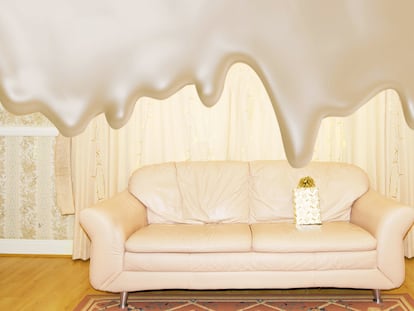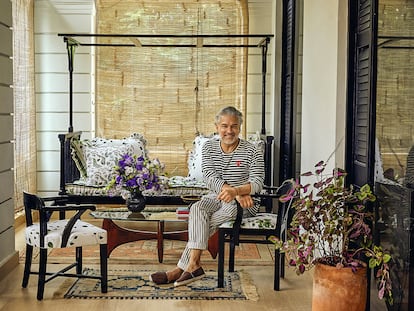Is white really the only color option when it comes to painting the ceiling?
The fear of dwarfing or suffocating the room usually stops us from painting the upper part of our rooms the same color as the walls, or even any color at all
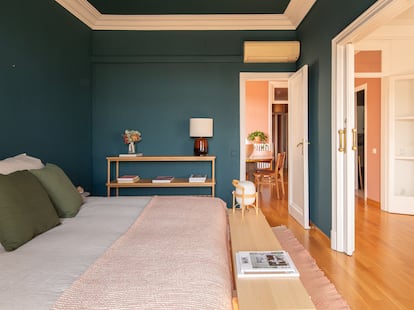
Should the ceiling always be white? Or, on the contrary, could it benefit from a note of color? It may be something that is not discussed or thought even about too much when taking on a home renovation, given that the consensus around the choice of white is well and truly understood.
In addition, doubts may naturally arise about the visual effect resulting from opting for another tone. Should we use colors if the house does not have particularly high ceilings? Could it have the optical effect of shrinking rooms that are not already very spacious? Nobody wants to make a mistake with something that they will see every day and that will often be the first thing they see when they wake up. Even so, in a time marked by interior designs that break the mold, examples have multiplied on social media as invitations to take the brave step. So, what aesthetic benefits can come from making such a bold gesture?
The decoration trends of recent years speak for themselves. There has been a shift in the aesthetic precepts that excite interior design experts, and it is a very colorful shift. Gone seems to be the love for almost clinical spaces painted brilliant white, in which earth tones, such as bamboo or linen displayed a certain natural appearance were reflected even in ornamental objects which aspired to plain colors and neat lines.
One could say all of this is already part of a cycle of fashion that displaces one trend in favor of another. Now home interiors, if you look at decoration platforms and websites, seem to want to express their own personality. An intention that has become as important as the quality of knowing just how much is the right amount, and carry out curatorial work on objects. It has been the aesthetic consequence of a time in which remote work has increased our focus on our home decor. In recent years, the fear of wallpaper, which carried so many demodé connotations, has been lost. There has been an official reconciliation with the long-suffering, sustainable, and austere terrazzo, and an affinity with the most unexpected shades of green. Furniture also seems to have something to say about the inhabitants. Taking all this into account, it is not so strange that the possibility of painting color on the ceilings is becoming increasingly popular.
The aesthetic benefits
A light blue with a grayish hue covers the ceiling of the apartment of creative consultant Michael Dansk, who has appeared in several media outlets that specialize in interior design. The color serves as a note to season a Scandinavian-style palette, dominated by white, along with some Mid-century wooden furniture and a selection of art pieces and design objects. In this case, the chosen shade of blue is also on the ceiling moldings, which softens the whole that would otherwise be a dazzling white.
From her apartment for rent in the United Kingdom, which is always full of color and decorative objects, Instagrammer Medina Grillo shares her satisfaction after making the decision to paint the ceiling of her bedroom a mustard yellow. “It is a joy to see this color every day when you wake up,” she tells her followers. “To add drama and sophistication to a room, try painting the ceiling,” read the headline of an article in The Washington Post as early as April 2022. “Painting the ceiling is the cheapest renovation if you are looking to add a design element,” a color expert told the publication. “It can completely change the look and feel of a space.” An interesting option for those who, like the followers of Medina Grillo, do not have the chance to undertake major renovations.
But, in addition to this economic or logistical advantage, there are other aesthetic advantages. A ceiling painted in a color other than white makes an impression on the visitor. It can help maintain a common thread, a chromatic dialogue with other decorative elements present in the room. The Barcelona-based architecture and interior design studio Somos Nido says that they are supporters of the use of color, and also of those same color accents reaching the ceiling. “It is a tool that helps us bring warmth and personality to spaces,” Giulia Mora, head of interior design at the studio, explains to EL PAÍS. She advocates the effect of color on ceilings to “create a deeper story in each of the rooms.”
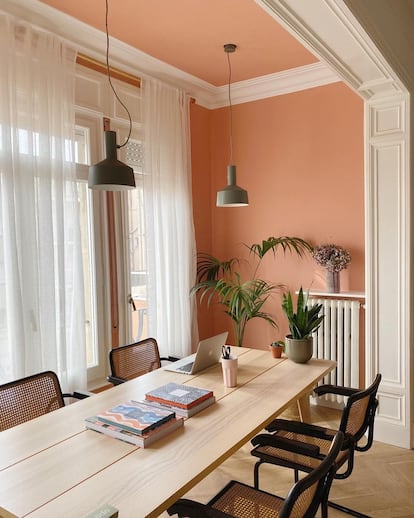
Useful ideas before painting the ceiling
Just as when choosing a new color for the walls, it is usually a good idea to do a test on the ceiling. It can be a gesture of caution and useful planning to gain perspective on the future outcome and, if necessary, change your mind. However, the decision requires a minimum sense of daring, creating an opportunity to be convinced. Mora points to one of the main fears of Somos Nido clients is that “people are generally afraid of painting the low ceilings of their rooms with color. However, they forget that this will lead to an attractive, special, welcoming space.”
The head of interior design gives an example. “Imagine a guest bathroom painted all yellow. It may seem crazy, but it will no longer be the bathroom with the low ceiling and will become the yellow bathroom.” It also highlights the character that the space adopts. It suggests imagining a black and white photo hanging on that yellow background. In some cases, like the one she describes, the color of the ceiling is coordinated with the walls and creates an “enveloping effect that produces and reinforces the concept that we developed from the beginning of the project.” This decision does not have to shrink the space. That uniformity of color can expand it visually, although it depends on the room and the light.
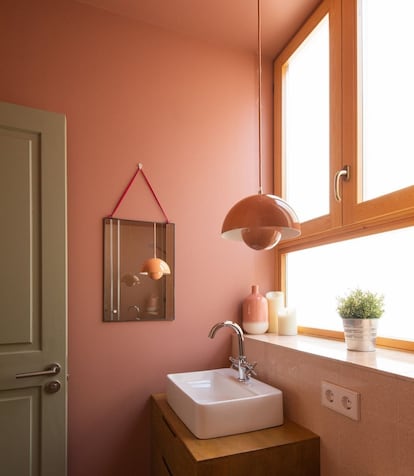
In addition to bringing a new level of design to the house, adding color to the ceiling can help hide imperfections, highlight architectural elements or details such as moldings and beams, and enhance the effect created by the natural or artificial light in the room. “There are always conditions, it depends on what we find in each project and what the message the home conveys when opening the door for the first time,” explains Mora, citing the moldings on the high ceilings of Barcelona’s Eixample and the exposed black beams and the brick of the houses in the Born neighborhood. “If there are spaces that already have a very strong personality, we try to respect it.”
It is a personal decision in which what each person wants to convey with their home prevails and, above all, the sensations with which they want to live inside their home. Of course, the expert provides advice for those who are determined to do it: paint everything, “even the air conditioning grilles and radiators. That way, you will make them disappear.”
Sign up for our weekly newsletter to get more English-language news coverage from EL PAÍS USA Edition
Tu suscripción se está usando en otro dispositivo
¿Quieres añadir otro usuario a tu suscripción?
Si continúas leyendo en este dispositivo, no se podrá leer en el otro.
FlechaTu suscripción se está usando en otro dispositivo y solo puedes acceder a EL PAÍS desde un dispositivo a la vez.
Si quieres compartir tu cuenta, cambia tu suscripción a la modalidad Premium, así podrás añadir otro usuario. Cada uno accederá con su propia cuenta de email, lo que os permitirá personalizar vuestra experiencia en EL PAÍS.
¿Tienes una suscripción de empresa? Accede aquí para contratar más cuentas.
En el caso de no saber quién está usando tu cuenta, te recomendamos cambiar tu contraseña aquí.
Si decides continuar compartiendo tu cuenta, este mensaje se mostrará en tu dispositivo y en el de la otra persona que está usando tu cuenta de forma indefinida, afectando a tu experiencia de lectura. Puedes consultar aquí los términos y condiciones de la suscripción digital.
More information
Últimas noticias
Most viewed
- Reinhard Genzel, Nobel laureate in physics: ‘One-minute videos will never give you the truth’
- Oona Chaplin: ‘I told James Cameron that I was living in a treehouse and starting a permaculture project with a friend’
- Pablo Escobar’s hippos: A serious environmental problem, 40 years on
- Charles Dubouloz, mountaineering star, retires at 36 with a farewell tour inspired by Walter Bonatti
- Why we lost the habit of sleeping in two segments and how that changed our sense of time
